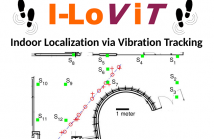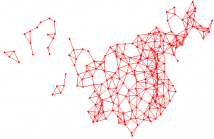
- Read more about Submodular Maximization with Multi-Knapsack Constraints and its Applications in Scientific Literature Recommendations
- Log in to post comments
Submodular maximization problems belong to the family of combinatorial optimization problems and enjoy wide applications. In this paper, we focus on the problem of maximizing a monotone submodular function subject to a d-knapsack constraint, for which we propose a streaming algorithm that
achieves a (1/1+2d − ε) -approximation of the optimal value,
- Categories:
 17 Views
17 Views
- Read more about I-LoViT: Indoor Localization by Vibration Tracking
- Log in to post comments
Signal processing techniques can create new applications for the data captured by existing sensor systems. Decades old sensor technology for monitoring the structural health of a building can serve a new role as a novel source of indoor localization data. Specifically, when a person's footstep-generated floor vibrations can be detected and located then it is possible to locate persons moving within a building. This emergent cyber-physical system holds the potential for an ambient localization service.
- Categories:
 12 Views
12 ViewsThis paper describes a model to address the task of named-entity recognition on Indonesian microblog messages due to its usefulness for higher-level tasks or text mining applications on Indonesian microblogs. We view our task as a sequence labeling problem using machine learning approach. We also propose various word-level and orthographic features, including the ones that are specific to the Indonesian language. Finally, in our experiment, we compared our model with a baseline model previously proposed for Indonesian formal documents, instead of microblog messages.
- Categories:
 15 Views
15 Views- Read more about Valence-Arousal Ratings Prediction with Co-occurrence Word-embedding
- Log in to post comments
Sentiment analysis draws increasing attention of researchers in wide-ranging fields. Compared with the commonly-used categorical
- Categories:
 13 Views
13 Views
- Read more about Robust Estimation of Self-Exciting Point Process Models with Application to Neuronal Modeling
- Log in to post comments
We consider the problem of estimating discrete self- exciting point process models from limited binary observations, where the history of the process serves as the covariate. We analyze the performance of two classes of estimators: l1-regularized maximum likelihood and greedy estimation for a discrete version of the Hawkes process and characterize the sampling tradeoffs required for stable recovery in the non-asymptotic regime. Our results extend those of compressed sensing for linear and generalized linear models with i.i.d.
- Categories:
 19 Views
19 ViewsWe present a novel method to hierarchically cluster networked data allowing nodes to simultaneously belong to multiple clusters. Given a network, our method outputs a cut metric on the underlying node set, which can be related to data coverings at different resolutions. The cut metric is obtained by averaging a set of ultrametrics, which are themselves the output of (non-overlapping) hierarchically clustering noisy versions of the original network of interest. The resulting algorithm is illustrated in synthetic networks and is used to classify handwritten digits from the MNIST database.
- Categories:
 13 Views
13 Views- Read more about Active Learning on Weighted Graphs Using Adaptive and Non-adaptive Approaches
- Log in to post comments
ppt_v2.pdf
- Categories:
 11 Views
11 Views
- Read more about BIPARTITE SUBGRAPH DECOMPOSITION FOR CRITICALLY SAMPLED WAVELET FILTERBANKS ON ARBITARY GRAPHS
- Log in to post comments
The observation of frequency folding in graph spectrum during down-sampling for signals on bipartite graphs—analogous to the same phenomenon in Fourier domain for regularly sampled signals—has led to the development of critically sampled wavelet filterbanks such as GraphBior. However, typical graph-signals live on general graphs that are not necessarily bipartite.
- Categories:
 10 Views
10 Views- Read more about Distributed Estimation via Paid Crowd Work
- Log in to post comments
Consider a distributed estimation problem to be carried out by paid crowdworkers, where results are to be returned quickly and accurately. Estimation accuracy is a function of the number of workers completing the job and of the quality of the workers, both of which may be influenced by the payment offered. With limited budget, payment allocation should consider both effects to obtain best results. Since people are not deterministic, payment offers will lead to a random number of variable-quality workers, as governed by choice models.
poster.pdf
- Categories:
 19 Views
19 Views